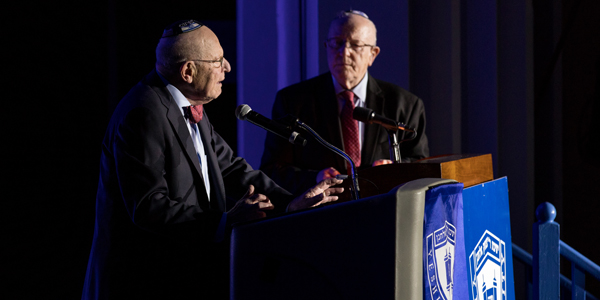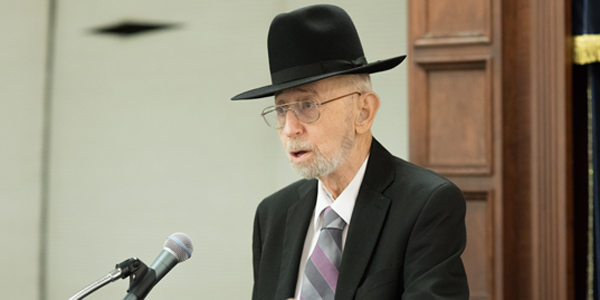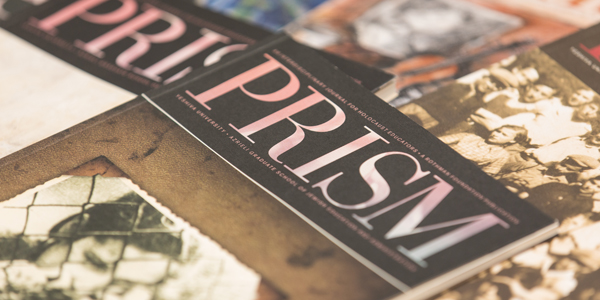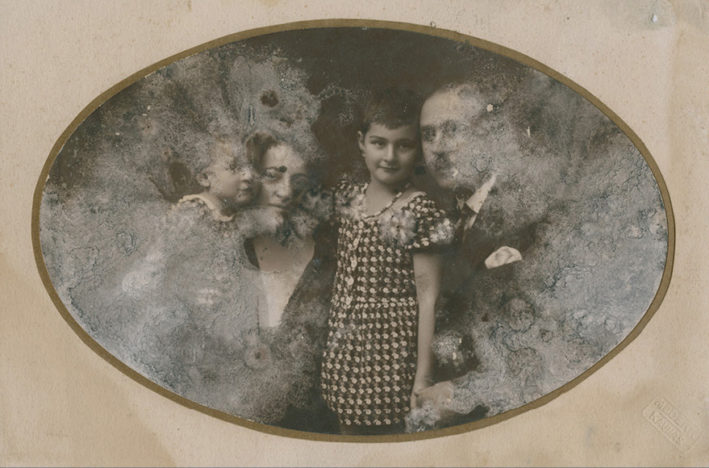Jan 27, 2019 By: yunews
Ensuring That What Happened Before Does Not Happen Again
On January 24, 2019, Naomi Azrieli, chair and CEO of the Azrieli Foundation, and Julius Berman, president of the Conference on Jewish Material Claims Against Germany (known as the Claims Conference), both of whom are members of the Board of Trustees of Yeshiva University, jointly announced the release of a comprehensive Holocaust Knowledge and Awareness Survey of adults in Canada. This follows a similar survey done in 2018 for the United States.
Both studies found a stunning ignorance of basic historical facts and a lack of detailed knowledge of the Holocaust. In the press release announcing the study, Berman noted that “as the UN International Holocaust Remembrance Day approaches, we are reminded of how important education is if we are to ensure that the atrocities of the Holocaust will never happen again.” (Click here to read an interview done with Julius Berman.)
International Holocaust Remembrance Day (IHRD) was established by the United Nations as a day for member states to honor the Jewish victims of the Holocaust and millions of other victims of Nazism. In many respects, Yeshiva University honors the mission of the IHRD year-round with events and programs aimed at both preserving the stories of survivors and promoting a wider awareness of the Holocaust.
For instance, the Student Holocaust Education Movement (SHEM) holds an annual commemoration honoring Holocaust survivors and victims in the storied Lamport Auditorium on the Wilf Campus. Last year’s event presented the stories of Bernard and Henry Schanzer, twin brothers whose family survived through the kindness of “righteous gentiles” in France who hid and protected them. Tali Naor ’18S, then-president of SHEM, said, “All of us sitting here in this room are living proof that the Nazis were wrong. We, the Jewish people, cannot be destroyed. Tonight, we will honor those who perished, those who survived, and those who dedicated their lives to telling their stories and ensuring that the memories of the Holocaust are never forgotten.”
 Henry Schanzer and Bernard Schanzer
Henry Schanzer and Bernard Schanzer Rabbi Meir Fulda z"l speaking about Kristallnacht in 2016
Rabbi Meir Fulda z"l speaking about Kristallnacht in 2016 In the past year, the Yeshiva University Museum has mounted two exhibitions that address Holocaust memory and memorialization: Lost & Found: A Family Photo Album and Kindertransport–Rescuing Children on the Brink of War.
Lost & Found displays the contents of a photo album smuggled out of the Kovno ghetto in 1943 and preserved by a non-Jewish family until 2016, when the album was returned to the original family (which included Dr. Jacob Wisse, director of the Museum and the great-nephew of Annushka Warshawska, the woman who smuggled photos out of the ghetto). Anna was deported with her two teenage daughters to a death camp in Estonia soon after, and the recovery of the album “fulfills one of Anna’s last acts,” said Dr. Wisse, “which was to preserve these images—and the memory of the people that appear in them—for future generations.”
In the past year, the Yeshiva University Museum has mounted two exhibitions that address Holocaust memory and memorialization: Lost & Found: A Family Photo Album and Kindertransport–Rescuing Children on the Brink of War.
Lost & Found displays the contents of a photo album smuggled out of the Kovno ghetto in 1943 and preserved by a non-Jewish family until 2016, when the album was returned to the original family (which included Dr. Jacob Wisse, director of the Museum and the great-nephew of Annushka Warshawska, the woman who smuggled photos out of the ghetto). Anna was deported with her two teenage daughters to a death camp in Estonia soon after, and the recovery of the album “fulfills one of Anna’s last acts,” said Dr. Wisse, “which was to preserve these images—and the memory of the people that appear in them—for future generations.”
 Portrait of Annushka Warshawska with her husband Leonas and their daughters Frida and Bella, around 1930
Portrait of Annushka Warshawska with her husband Leonas and their daughters Frida and Bella, around 1930 Lucy Lang, a trustee of the YU Museum and another Kinder sent to safety from her native Vienna, Austria, spoke about how important it is for people to understand the sacrifices parents made when they sent their children away, “not knowing whether they would ever see us again,” especially when, as it turned out, the great majority of the children sent away never had the chance to reunite with their families. “We all have to appreciate our parents and feel good that we have our children with us and that we can take care of them.”
Responses by visitors to Kindertransport demonstrate the overwhelming importance of exhibitions like this in keeping the memory of this dangerous time alive and vibrant. According to Ilona Moradof, associate director of administration and special projects at the Museum and curator of the exhibition, and Ilana Benson, director of museum education, the event has drawn a diverse audience, among them Kinder and their families, school and synagogue groups, locals and tourists, and Jews and non-Jews.
Lucy Lang, a trustee of the YU Museum and another Kinder sent to safety from her native Vienna, Austria, spoke about how important it is for people to understand the sacrifices parents made when they sent their children away, “not knowing whether they would ever see us again,” especially when, as it turned out, the great majority of the children sent away never had the chance to reunite with their families. “We all have to appreciate our parents and feel good that we have our children with us and that we can take care of them.”
Responses by visitors to Kindertransport demonstrate the overwhelming importance of exhibitions like this in keeping the memory of this dangerous time alive and vibrant. According to Ilona Moradof, associate director of administration and special projects at the Museum and curator of the exhibition, and Ilana Benson, director of museum education, the event has drawn a diverse audience, among them Kinder and their families, school and synagogue groups, locals and tourists, and Jews and non-Jews.
 Eva Kollisch and her brothers traveled on the Kindertransport and were reunited with their parents in the US after the war. Pictured is the extended family of Eva Kollisch, who attended the exhibition.
Eva Kollisch and her brothers traveled on the Kindertransport and were reunited with their parents in the US after the war. Pictured is the extended family of Eva Kollisch, who attended the exhibition.
 Henry Schanzer and Bernard Schanzer
Henry Schanzer and Bernard Schanzer Rabbi Meir Fulda z"l speaking about Kristallnacht in 2016
Rabbi Meir Fulda z"l speaking about Kristallnacht in 2016 In the past year, the Yeshiva University Museum has mounted two exhibitions that address Holocaust memory and memorialization: Lost & Found: A Family Photo Album and Kindertransport–Rescuing Children on the Brink of War.
Lost & Found displays the contents of a photo album smuggled out of the Kovno ghetto in 1943 and preserved by a non-Jewish family until 2016, when the album was returned to the original family (which included Dr. Jacob Wisse, director of the Museum and the great-nephew of Annushka Warshawska, the woman who smuggled photos out of the ghetto). Anna was deported with her two teenage daughters to a death camp in Estonia soon after, and the recovery of the album “fulfills one of Anna’s last acts,” said Dr. Wisse, “which was to preserve these images—and the memory of the people that appear in them—for future generations.”
In the past year, the Yeshiva University Museum has mounted two exhibitions that address Holocaust memory and memorialization: Lost & Found: A Family Photo Album and Kindertransport–Rescuing Children on the Brink of War.
Lost & Found displays the contents of a photo album smuggled out of the Kovno ghetto in 1943 and preserved by a non-Jewish family until 2016, when the album was returned to the original family (which included Dr. Jacob Wisse, director of the Museum and the great-nephew of Annushka Warshawska, the woman who smuggled photos out of the ghetto). Anna was deported with her two teenage daughters to a death camp in Estonia soon after, and the recovery of the album “fulfills one of Anna’s last acts,” said Dr. Wisse, “which was to preserve these images—and the memory of the people that appear in them—for future generations.”
 Portrait of Annushka Warshawska with her husband Leonas and their daughters Frida and Bella, around 1930
Portrait of Annushka Warshawska with her husband Leonas and their daughters Frida and Bella, around 1930 Lucy Lang, a trustee of the YU Museum and another Kinder sent to safety from her native Vienna, Austria, spoke about how important it is for people to understand the sacrifices parents made when they sent their children away, “not knowing whether they would ever see us again,” especially when, as it turned out, the great majority of the children sent away never had the chance to reunite with their families. “We all have to appreciate our parents and feel good that we have our children with us and that we can take care of them.”
Responses by visitors to Kindertransport demonstrate the overwhelming importance of exhibitions like this in keeping the memory of this dangerous time alive and vibrant. According to Ilona Moradof, associate director of administration and special projects at the Museum and curator of the exhibition, and Ilana Benson, director of museum education, the event has drawn a diverse audience, among them Kinder and their families, school and synagogue groups, locals and tourists, and Jews and non-Jews.
Lucy Lang, a trustee of the YU Museum and another Kinder sent to safety from her native Vienna, Austria, spoke about how important it is for people to understand the sacrifices parents made when they sent their children away, “not knowing whether they would ever see us again,” especially when, as it turned out, the great majority of the children sent away never had the chance to reunite with their families. “We all have to appreciate our parents and feel good that we have our children with us and that we can take care of them.”
Responses by visitors to Kindertransport demonstrate the overwhelming importance of exhibitions like this in keeping the memory of this dangerous time alive and vibrant. According to Ilona Moradof, associate director of administration and special projects at the Museum and curator of the exhibition, and Ilana Benson, director of museum education, the event has drawn a diverse audience, among them Kinder and their families, school and synagogue groups, locals and tourists, and Jews and non-Jews.
 Eva Kollisch and her brothers traveled on the Kindertransport and were reunited with their parents in the US after the war. Pictured is the extended family of Eva Kollisch, who attended the exhibition.
Eva Kollisch and her brothers traveled on the Kindertransport and were reunited with their parents in the US after the war. Pictured is the extended family of Eva Kollisch, who attended the exhibition.